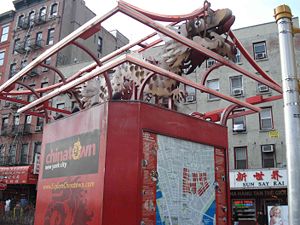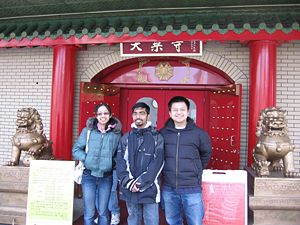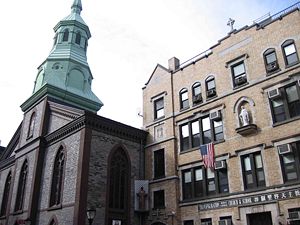From The Peopling of New York City
Visit 2-Saturday-March 9:00 A.M.
Not many people at this time, but it filled up some time after 10:00 A.M.
On our second trip to Chinatown, we experienced so much more because we were more familiar with the area. Nonetheless, we decided to take an overall tour of Chinatown. A map located right in the center of Chinatown directed us to some of the more well-known & well established sights. On this general walking tour, we paid much more attention to the types of buildings that lined the streets. The main street, Canal Street, is filled with many shops of course. However, there are some side streets which were narrow and which contained so many signs in Chinese. We hadn't noticed these as much before, but now they caught our attention (and our cameras). Also, we noticed much more cultural diffusion. We saw businesses that mixed both the American and Chinese culture. You would see both English and Chinese written on an American Business, and vice versa. For example, Chase Bank and McDonalds all seemed to be diffused with Chinese. It was interesting to see the contrast.
After walking from the N/R Train Station, along Canal Street to the other end of Chinatown (up until Confucius Plaza, near the road to Manhattan Bridge), and getting a general feel of the area, we visited the Buddhist Temple, the largest religious space in Chinatown. Before we saw this site, however, it must be mentioned that Confucious Plaza has a huge stone arch right in the center and there were no people at all, which was such a contrast to the busyness of the rest of Chinatown.
The Buddhist Temple in Chinatown amazed all three of us. Even as we walked in, the scents provided a welcoming atmosphere, as did the sound of calmness. It was pretty quiet in the temple, and we walked cautiously down a hallway which opened up to the main room of the temple. There was a huge golden statue of the Buddha which caught our attention right away. In the room was a table where a religious service was beginning. We observed the ceremony for a little while, watching as both men and women, young and old, put on black robes, and proceeded to sit down at a table. One man drummed a beat against a curved drum, as the others chanted in another language. We were not allowed to take any pictures anywhere inside the temple, but we were allowed to visit the museum/gift-shop area upstairs. Here, we could see how much of Chinese culture and Buddhism was preserved. It seemed to be the most cultural place in Chinatown- statues, face-reading charts, luck charms (which John happened to buy), scents (including one for Dragons Blood), books on Buddhism, etc. all could be purchased here. It was truly a museum space because we learned much about the culture just from looking at the unique objects that adorned the room.
We interviewed the shopkeeper, an elderly woman who decided to remain anonymous. We asked her about her relations with Chinatown, so that we could get a social aspect and perhaps even a historical aspect of Chinatown. She quietly replied that she had been working in the store for a few years, some time less than ten years. Additionally, we were informed by her that the Chinese are a "very simple people, we don't like fighting." The elderly shopkeeper also told us that she has noticed a change in Chinatown- the population has been increasing every year. Also, when asked why she likes Chinatown and what has attracted her to it, she notified us that it's simply a convenience since she is Chinese herself.
After a visit to the shop, we saw Transfiguration Church, another religious space in Chinatown. This is a Christian space. It caught our eyes because of its high elevation, which seems to be reaching for the sky. It is adorned with a cross at the very tip. Along with it is a school. It's interesting how two religions seem to co-exist within the same area.
We also checked out underground economy... literally. Underground stores, or stores that were really under the ground, lol, were located everywhere. We decided to go to an underground restaurant, not only to eat, but to learn how to use chopsticks and learn about the cuisine from the menu. The menu included fried octopus balls and squid.
Furthermore, we took a walk on East Broadway, a street that runs parallel to Canal Street, and also contains Chinese businesses. Here, we decided to visit a supermarket so that we could get some a food aspect of Chinatown. We didn't see the usual types of food- squid, fish (with their eyes), and all sorts of animals were located in the aisles. The strong smell of seafood lurked in the air. The supermarket was very busy, filled with many shoppers. On East Broadway, we could see a clear definition between Chinatown, and another completely different area. In this area, there were no Chinese shops. Instead, we could see apartment buildings and a clear view of the Verizon Tower.


